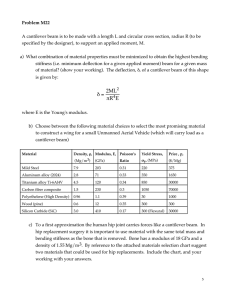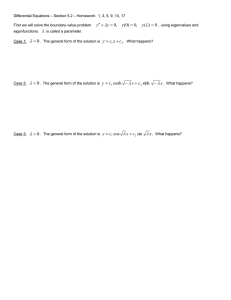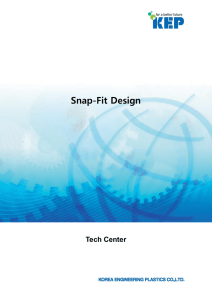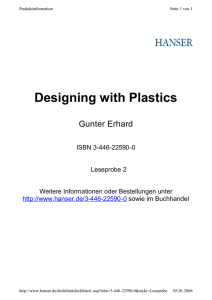BASF Snap-Fit Design Manual
advertisement
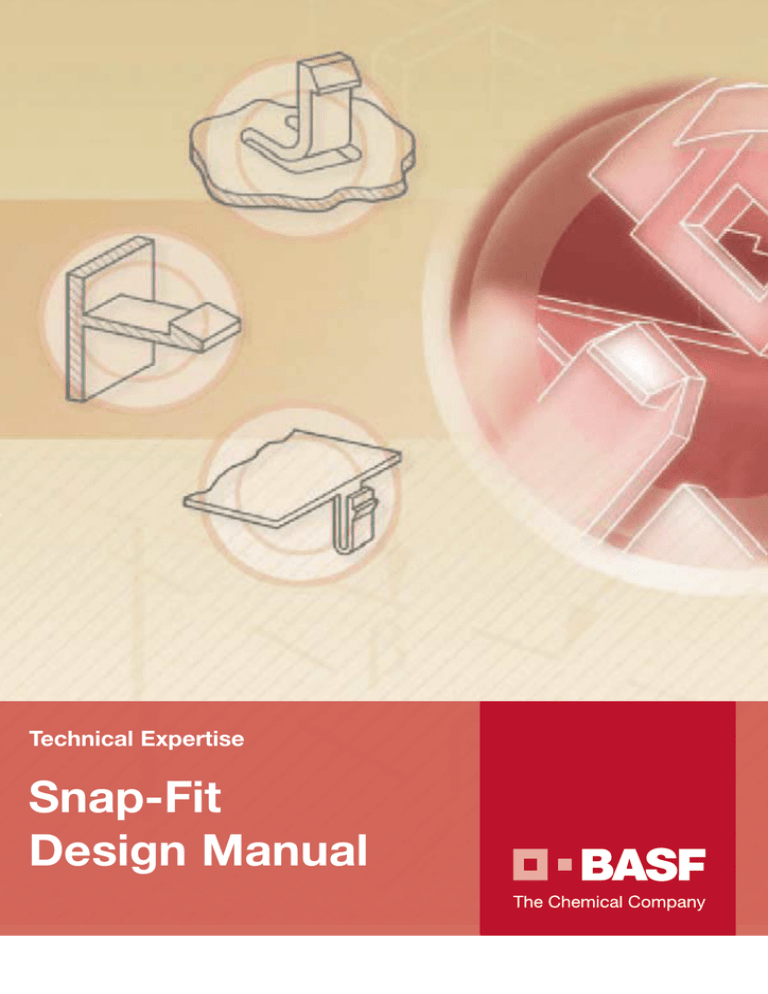
Technical Expertise
Snap-Fit
Design Manual
Table of Contents
Topic
Part
Introduction. . . . . . . . . . . . . . . . . . . . . . . . . . . . . . . . . . . . . . . . . . . Introduction
Snap-Fit Design Applications. . . . . . . . . . . . . . . . . . . . . . . . . . . . . . . . . . I
Types of Snap-Fits . . . . . . . . . . . . . . . . . . . . . . . . . . . . . . . . . . . . . . . . . . II
Snap-Fit Beam Design Using Classical Beam Theory . . . . . . . . . . . . . III
Improved Cantilever Snap-Fit Design. . . . . . . . . . . . . . . . . . . . . . . . . . . IV
U
“ “ & L“ “ Shaped Snaps . . . . . . . . . . . . . . . . . . . . . . . . . . . . . . . . . . . . . . . . V
General Design Guidelines . . . . . . . . . . . . . . . . . . . . . . . . . . . . . . . . . . . VI
English/Metric Conversion Chart . . . . . . . . . . . . . . . . . . . . . . . Inside Back Cover
Introduction
Snap-Fit Design
This manual will guide you through the
basics of snap-fit design, including: types
of snap-fit designs and their applications;
how to calculate the strength of the unit and
amount of force needed for assembly; and the
three common causes of failure in snap-fits
and how to overcome them.
About BASF Performance Polymers
BASF Plastics is a fully integrated, global supplier of
engineering resins “ from production of feedstocks to the
compounding, manufacture and distribution of hundreds
of resin grades.
BASF is committed to continuous product development to
sustain rapid growth in the nylon resin market. In our
Plastics Technology Laboratory, a highly experienced staff
of research and development engineers continues to
develop new resins to further extend the horizons of
product performance.
BASF offers high-quality engineering resins, including:
U
“ ltramid® (nylon 6 and 6/6)
Nypel® (a post-industrial nylon 6)
P
“ etra®“ (post-consumer recycled PET)
U
“ ltradur®“ PBT Thermoplastic Polymer
Ultraform®“ Acetal (POM)
Ultrason®“ High Temp Polymers
These resins from BASF, coupled with the company’s
concept-through-commercialization expertise, can
combine to help make possible the most efficient, costeffective snap-fit for your product. Our technical support is
ready to help you with all your needs. And for more
information, you can always visit our web site at
www.plasticsportal.com./usa
Part I
Snap-Fit Design Applications
Why use snap-fits? This chapter will give you a thumbnail
sketch of the benefits of snap-fits and the materials used
to make them.
Snap-fits are the simplest, quickest and most costeffective method of assembling two parts. When designed
properly, parts with snap-fits can be assembled and
disassembled numerous times without any adverse effect
on the assembly. Snap-fits are also the most
environmentally friendly form of assembly because
of their ease of disassembly, making components of
different materials easy to recycle.
Although snap-fits can be designed with many materials,
the ideal material is thermoplastic because of its high
flexibility and its ability to be easily and inexpensively
molded into complex geometries. Other advantages
include its relatively high elongation, low coefficient of
friction, and sufficient strength and rigidity to meet the
requirements of most applications.
The designer should be aware that the assembly may have
some p
“ lay“ due to tolerance stack-up of the two mating
parts. Some snap-fits can also increase the cost
of an injection molding tool due to the need for slides in the
mold. An experienced designer can often eliminate the
need for slides by adding a slot in the wall directly below
the undercut or by placing the snaps on the edge of the
part, so they face outward (see Figure I-1).
UNDERCUT
REQUIRES SLIDE IN MOLD
SLOT
NO SLIDE REQUIRED
NO SLIDE REQUIRED,
MOLD LESS COMPLEX
Figure I-1
I-1
SNAP-FIT DESIGN APPLICATIONS
Concluding points: Snap-fits solve the problem of
creating an inexpensive component that can be quickly
and easily joined with another piece. Thermoplastics
are the ideal material for snap-fits because they have the
flexibility and resilience necessary to allow for numerous
assembly and disassembly operations.
Door handle bezel
Backside of bezel
I-2
Detail of backside of bezel, cantilever design
Part II
Types of Snap-Fits
This chapter provides an overview of the different types of
cantilever snap-fits and gives an idea of when they are used.
Most engineering material applications with snap-fits use the
cantilever design (see Figure II-1) and, thus, this manual will
focus on that design. The cylindrical design can be
employed when an unfilled thermoplastic material with
higher elongation will be used (a typical application is an
aspirin bottle/cap assembly).
When designing a cantilever snap, it is not unusual for the
designer to go through several iterations (changing length,
thickness, deflection dimensions, etc.) to design a snap-fit
with a lower allowable strain for a given material.
Other types of snap-fits, which can be used, are the U
“ “
or L
“ “ shaped cantilever snaps (see Part V for more detail).
These are used when the strain of the straight cantilever
snap cannot be designed below the allowable strain for the
given material.
Concluding points: Most applications can employ a
cantilever type snap-fit in the design. In applications with
tight packaging requirements, the U
“ “ or L
“ “ shaped snap may
be required.
Y
CANTILEVER
“U” SHAPED CANTILEVER
Automotive oil filter snaps
“L” SHAPED CANTILEVER
Figure II-1
Cordless screw driver housing, cantilever snap-fit
II-1
;
;;
Part III
Snap-Fit Design Using Classical Beam Theory
A design engineer’s job is to find a balance between
integrity of the assembly and strength of the cantilever
beam. While a cantilever beam with a deep overhang
can make the unit secure, it also puts more strain on the
beam during assembly and disassembly. This chapter
explains how this balance is achieved.
MATING FORCE
P
R
α'
W
α
A typical snap-fit assembly consists of a cantilever beam
with an overhang at the end of the beam (see Figure III-1).
The depth of the overhang defines the amount of
deflection during assembly.
R
}
FRICTION CONE
ENTRANCE SIDE
P
α+ β
W
β
α
RETRACTION SIDE
Friction Coefficient µ = tan β
Mating Force
OVERHANG DEPTH
Figure III-1
=W
W = P tan(α + β)
µ—+
tan
α——
——
——
W =P—
1– µ tan α
Figure III-2
The overhang typically has a gentle ramp on the entrance
side and a sharper angle on the retraction side. The small
angle at the entrance side (α) (see Figure III-2) helps to
reduce the assembly effort, while the sharp angle at the
retraction side (α“) makes disassembly very difficult or
impossible depending on the intended function. Both the
assembly and disassembly force can be optimized by
modifying the angles mentioned above.
III-1
The main design consideration of a snap-fit is integrity
of the assembly and strength of the beam. The integrity of
the assembly is controlled by the stiffness (k) of the beam
and the amount of deflection required for assembly or
disassembly. Rigidity can be increased either by using a
higher modulus material (E) or by increasing the cross
sectional moment of inertia (I) of the beam. The product of
these two parameters (EI) will determine the total rigidity of
a given beam length.
SNAP-FIT DESIGN USING CLASSICAL BEAM THEORY
The integrity of the assembly can also be improved by
increasing the overhang depth. As a result, the beam
has to deflect further and, therefore, requires a greater
effort to clear the overhang from the interlocking hook.
However, as the beam deflection increases, the beam
stress also increases. This will result in a failure if the beam
stress is above the yield strength of the material.
Cantilever Beam: Deflection-Strain Formulas
P
t
L
b
Thus, the deflection must be optimized with respect to the
yield strength or strain of the material. This is achieved by
optimizing the beam section geometry to ensure that the
desired deflection can be reached without exceeding the
strength or strain limit of the material.
I ) Uniform Cross Section,
Fixed End to Free End
Stiffness: k = P = Eb t
L
Y
4
t
Strain: E = 1.50
Y
L2
( )
( )
The assembly and disassembly force will increase with
both stiffness (k) and maximum deflection of the beam (Y).
The force (P) required to deflect the beam is proportional
to the product of the two factors:
P= kY
P
When selecting the flexural modulus of elasticity (E)
for hygroscopic materials, i.e., nylon, care should be taken.
In the dry as molded state (DAM), the datasheet value may
be used to calculate stiffness, deflection or retention force
of snap design. Under normal 50% relative humidity
conditions, however, the physical properties decrease
and, therefore, the stiffness and retention force reduce
while the deflection increases. Both scenarios should be
checked.
t
2
t
The stiffness value (k) depends on beam geometry as
shown in Figure III-3.
Stress or strain induced by the deflection (Y) is also shown
in Figure III-3. The calculated stress or strain value should
be less than the yield strength or the yield strain of the
material in order to prevent failure.
3
L
b
II ) Uniform Width, Height Tapers
to t/2 at Free End
t
Stiffness: k = P = Eb
Y 6.528 L
Strain: E = 0.92 t2 Y
L
( )
()
b
3
P
t
L
b
4
III ) Uniform Height,Width Tapers
to b/4 at Free End
t
Stiffness: k = P = Eb
Y 5.136 L
Strain: E =1.17 t2 Y
L
( )
3
()
Where:
E = Flexural Modulus
P = Force
Y = Deflection
b = Width of Beam
Figure III-3
III-2
SNAP-FIT DESIGN USING CLASSICAL BEAM THEORY
Concluding points: In a typical snap-fit, the strength
of a beam is dependent on its geometry and maximum
deflection during assembly. The force to assemble and
disassemble snap-fit assemblies is highly dependent on
the overhang entrance and retraction angles.
Close-up of automotive fuse box, snap on sides of box
Close-up of automotive fuse box, full view
III-3
Close-up of automotive fuse box snap
Part IV
Improved Cantilever Snap-Fit Design
The cantilever beam formulas used in conventional
snap-fit design underestimate the amount of strain at
the beam/wall interface because they do not include the
deformation in the wall itself. Instead, they assume the wall
to be completely rigid with the deflection occurring only in
the beam. This assumption may be valid when the ratio of
beam length to thickness is greater than about 10:1.
However, to obtain a more accurate prediction of total
allowable deflection and strain for short beams, a
magnification factor should be applied
to the conventional formula. This will enable greater
flexibility in the design while taking full advantage of
the strain-carrying capability of the material.
BASF Plastics has developed a method for estimating
these deflection magnification factors for
various snap-fit beam/wall configurations as shown
in Figure IV-1. The results of this technique, which
have been verified both by finite element analysis and
actual part testing1, are shown graphically in Figure IV-1.
Figure IV-2 shows similar results for beams of
tapered cross section (beam thickness decreasing
by 1/2 at the tip).
Snap-Fit Design Examples 1 & 2 illustrate this procedure
for designing snap-fits, including calculating the maximum
strain developed during assembly and predicting the snapin force required.
1 Chul S. Lee, Alan Dubin and Elmer D. Jones, S
“ hort Cantilever Beam
Deflection Analysis Applied to Thermoplastic Snap-Fit Design,“ 1987 SPE
ANTEC, held in Los Angeles, California, U.S.A.
IV-1
IMPROVED CANTILEVER SNAP-FIT DESIGN
8.0
1
ON A BLOCK
(SOLID WALL)
7.0
6.0
4
2
DEFLECTION MAGNIFICATION FACTOR Q
ON A PLATE
(OR THIN WALL)
3
5.0
5
4.0
3.0
2.0
1.0
0.0
0.0
1.0
2.0
3.0
4.0
5.0
6.0
7.0
ASPECT RATIO, L/t
Uniform Beam, Q Factor
Figure IV-1
IV-2
8.0
9.0
10.0
11.0
;
IMPROVED CANTILEVER SNAP-FIT DESIGN
8.0
t/2
7.0
t
DEFLECTION MAGNIFICATION FACTOR Q
6.0
2T
5T
5.0
4.0
5T
3.0
2.0
2T
1.0
0.0
0.0
1.0
2.0
3.0
4.0
5.0
6.0
7.0
8.0
9.0
10.0
11.0
ASPECT RATIO, L/t
Tapered Beam, Q Factor
Figure IV-2
IV-3
;
IMPROVED CANTILEVER SNAP-FIT DESIGN
Allowable Strain Value, eo
Improved Formulas
b
t
P
W
Y
α
L
Figure IV-3
MAXIMUM STRAIN (@ BASE)
tY
∈ = 1.5 —
——L2 Q
MATING FORCE
+—
tan
W = P µ——
——α
——
1– µ tan α
2
∈
E—
P = bt
—
—
—
—
—
—
6L
Where:
W = Push-on Force
W’ = Pull-off Force
P = Perpendicular Force
µ = Coefficient of Friction
α = Lead Angle
α’ = Return Angle
b = Beam Width
t = Beam Thickness
L = Beam Length
E = Flexural Modulus
∈ = Strain at Base
∈o = Allowable Material Strain
Q = Deflection Magnification Factor
(refer to Figure IV-2 for proper
Q values)
Y = Deflection
MATERIAL
PEI
PC
Acetal
Nylon 6(4)
PBT
PC/PET
ABS
PET
UNFILLED
9.8%(2)
4%(1) - 9.2%(2)
7%(1)
8%(5)
8.8%(2)
5.8%(2)
6% - 7%(3)
2.0%
2.1%(1)
2.0%
1.5%(1)
Table IV-I
NOTES:
(1)
70% of tensile yield strain value
(2)
G.G. Trantina. Plastics Engineering.
August 1989.
(3)
V.H. Trumbull. 1984 ASME Winter Annual Conference
(4)
DAM - D
“ ry As Molded“ condition
(5)
BASF test lab; Note 4% should be used in Mating Force
Formula
Coefficient of Friction(1)
MATERIAL
PEI
PC
Acetal
Nylon 6
PBT
PC/PET
ABS
PET
µ
0.20 - 0.25
0.25 - 0.40
0.20 - 0.35
0.17 - 0.40
0.35 - 0.40
0.40 - 0.50
0.50 - 0.60
0.18 - 0.25
Table IV-II
NOTES:
(1)
Material tested against itself
Wheel cover with cantilever snaps
IV-4
30% GLASS
;;
IMPROVED CANTILEVER SNAP-FIT DESIGN
Snap-Fit Design Example #1
Uniform Beam - Type 4
Snap-Fit Design Example #2
Uniform Beam - Type 5
GIVEN:
b
t
Material ⇒ Ultradur B4300 G3
(PBT)
P
W
Y
L
α
t = 3 mm
L = 15 mm
b = 6 mm
E = 4830 MPa
µ = 0.3
α = 30.0°
∈o = 2.5%
GIVEN:
Material ⇒ Unfilled
Acetal
P
Y
L
t
b
t
Y
L
b
=
=
=
=
0.063 in
0.090 in
0.225 in
0.242 in
Figure IV-5
DETERMINE:
IS THIS TYPE OF SNAP-FIT ACCEPTABLE FOR USE IN
ACETAL (ULTRAFORM N2320 003)
Figure IV-4
DETERMINE:
A) THE MAXIMUM DEFLECTION OF SNAP
B) THE MATING FORCE
SOLUTION:
A) THE MAXIMUM ALLOWABLE DEFLECTION OF SNAP
2
∈o L—
Q—
max
∈o = 1.5 tY
——
—- ⇒ Ymax = —
—
L2 Q
1.5 t
L = 5.0 ⇒ Q = 2.07 (from Q Factor Graph)
—
t
(0.025)(15)2 (2.07)
Ymax = —————————— = 2.59 mm
1.5(3)
Therefore, in an actual design, a smaller value for deflection
(Y) would be chosen for an added factor of safety.
SOLUTION:
tY
∈ = 1.5 —
——L2 Q
(From Q Factor Graph,
Figure IV-1)
L = 3.57 ⇒ Q = 2.7
—
t
(0.063)(0.090)
∈ = 1.5 ——
——————— = 6.2%
(0.225)2(2.7)
Therefore, it is acceptable for unfilled acetal (POM)
(See Allowable Strain Value, Table IV-1).
Concluding points: Unlike conventional formulas, BASF
includes the deflection magnification factor in all calculations.
The examples show how to calculate the maximum strain
during assembly and how to predict
the force needed for assembly.
B) THE MATING FORCE
2
∈
E—
bt—
o
P=—
—
—
—
6L
6(3)2 (4830)(0.025)
P = ——————————— = 72.45 N
6(15)
+—
tan
W = P µ——
——a——
1– µ tan a
0.3 + tan30º
W = 72.45 ———————— = 76.9 N
1– 0.3 (tan30º)
Therefore, it will take 76.9 N mating force to
assemble parts, if the part deflected to the material’s
allowable strain.
Close-up of automotive wheel cover snaps
IV-5
Part V
;;
;
U
“ “&L
“ “ Shaped Snaps
The cantilever beam snap-fit design isn’t appropriate
for all applications. This chapter defines L
“ “ and U
“ “ shaped
snaps and tells when they are used.
Occasionally, a designer will not be able to design a
cantilever snap-fit configuration with a strain below the
allowable limit of the intended material. This is usually due
to limited packaging space which can restrict the length of
the snap. This is the ideal time to consider using either an
L
“ “ shaped snap or a U
“ “ shaped snap.
The L
“ “ shaped snap (see Figure V-1) is formed by designing
in slots in the base wall which effectively increases the
beam length and flexibility compared to a standard
cantilever beam. This allows the designer to reduce the
strain during assembly below the allowable limit of the
selected material. It should be noted that adding a slot to
the base wall may not be acceptable in some designs for
cosmetic or air flow concerns.
The U
“ “ shaped snap (see Figure V-2) is another way to
increase the effective beam length within a limited space
envelope. With this design, even materials with low
allowable strain limits (such as highly glass-filled materials)
can be designed to meet assembly requirements. The
U
“ “ shaped design usually incorporates the undercut on the
outer edge of the part to eliminate the need for slide in the
mold, unless a slot is acceptable in the wall from which the
snap projects.
V-1
“L” SHAPED CANTILEVER
Figure V-1
“U” SHAPED CANTILEVER
Figure V-2
“U“ & “L“ SHAPED SNAPS (CONSTANT CROSS SECTION)
L
“ “ SHAPED SNAP–FIT
L Shaped Snap-Fit Example
A) Calculate the minimum length (L2) of the slot (see
sketch, Figure V-3) in the main wall for Ultramid 8233 nylon
in the configuration below. The required deflection is .38
inches.
P
L1
t
A
A
b
R
Section
A-A
L2
B) Calculate the required force (P) to deflect the
snap .38 inches.
GIVEN:
∈8233 = .025
t = .1 in
L1 = .5 in
R = .12 in
I = Moment of Inertia (rectangle)
3
1(.1)3
I = bt =
= 8.333(10-5)
12
12
E = 1.31 (106)
b = 1.0 in
Y = .38
Figure V-3
(6/∈o)Yt(L1+ R) - 4L13 - 3R(2πL12 + πR2 + 8L1R)
L2 = ———
——————————
———-----–––——–————
12(L1 +R)2
or,
Y=
P
[4L 3+3R(2πL12 +πR2 + 8L1R) + 12L2(L1 + R)2]
12EI 1
Where:
L2 = Length of slot as shown in sketch
∈o = Allowable strain of material
Y = Maximum deflection required in direction
of force
t = Thickness
L1 = Length as shown in sketch
R = Radius as shown in sketch
(at neutral axis)
P = Force
b = Beam Width
E = Flexural Modulus
I = Moment of Inertia
(6/∈) Yt(L + R) - 4L13 - 3R(2πL12 + πR2 + 8L1R)
A) L2 = —–––––———1 —————
——————————————
12(L1 +R)2
(6/.025)(.38)(.1)(.62) - 4(.5)3 - .36[.5π +.122π + 4(.12)]
= —————————————2———————————––
12(.62)
L2 = 0.954 in
B) Y = P [4L13+3R(2πL12 +πR2 + 8L1R) + 12L2(L1 + R)2]
12EI
.38 =
P
(12)(1.31)(106)(8.333)(10-5)
[4(.5)3+(.36)[.5π+
.122π+ 8(.5).12]+ 12(0.954)(.62)2]
.38 =
P
(5.655
1.31(103)
P = 88 lb
V-2
“U“ & “L“ SHAPED SNAPS
U
“ Shaped Snap
Example #1
U Shaped Snap–Fit
P
P
t
L1
L1
b
L2
L2
R
A
R
A
Section
A-A
Case 1
Case 1
Y=
∈
9(L1 + R)t
A) Calculate the amount of deflection at the tip of the
beam for a 1.0 pound load
[6L + 9R {L1(2πL1 + 8R) + πR }+
3
1
2
6L2 (3L12 - 3L1L2 +L22 )]
GIVEN:
P = 1.0 lb
I = 0.833 x 10-4 in4 = bt3/12 (rectangular cross section)
E = 534,000 psi
R = 0.15 in
L1= 1.4 in
L2= 0.973 in
t = 0.1 in
b = 1.0 in
or,
Y = P [6L13 + 9R {L1(2πL1 + 8R) + πR2}+
18EI
6L2 (3L12 - 3L1L2 +L22 )]
L3
A) Y = P [ 6L13 + 9R{L1(2πL1 + 8R) + πR2} + 6L2(3L12 - 3L1L2 + L22)]
18EI
1
[6(1.4)3 +9(0.15){(1.4)
Y=
18(534,000)(0.833 x 10-4)
t
P
L2
b
L1
A
R
A
Section
A-A
Case 2
Y=
∈
3(L 1 + R)t
[4L 13 + 2L 33 +3R {L 1(2πL 1 + 8R) + πR2}]
or,
Y = P [4L 13 + 2L 33 +3R {L 1(2πL 1 + 8R) + πR2}]
6EI
Where:
Variables defined on previous page.
V-3
(2π•1.4 + 8 • 0.15) + π(0.15)2} + 6 (0.973)
{3(1.4)2 - 3(1.4)(0.973) + (0.973)2}]
= 0.064 in
“U“ & “L“ SHAPED SNAPS
U
“ “ Shaped Snap
Example #2
Concluding points: Snap-fits can use either the U
“ “ or L
“ “
shaped design to overcome space limitations. Both the L
“ “
and U
“ “ shaped snaps effectively reduce strain during
assembly, thus making it ideal for materials with lower
allowable strain limits.
L3
L2
L1
P
R
CASE 2 Example 2
Case 2
A) Calculate the amount of deflection at the tip of the
beam for a 1.0 pound load
GIVEN:
I = 0.833 x 10-4 in4
E = 534,000 psi
R = 0.15 in
L1 = 0.7 in
L1 = L2
L3 = 0.273 in
t = 0.1 in
Y =
=
Automotive wheel cover
P
[4L 3 + 2L33 + 3R {L1(2πL1 + 8R) + πR2}]
6EI 1
1
[4(0.7)3 + 2(0.273)3 +
6(534,000)(0.833 x 10-4)
3(0.15){0.7(2π • 0.7 + 8(0.15)) + π (0.15)2}]
= 0.012 in
Close-up of above cover backside featuring the L
“ “ shaped snap-fit
design (from a top angle)
Inset shot of a U
“ “ shaped snap-fit design
V-4
;;
;;;;
Part VI
General Design Guidelines
Three basic issues should be reviewed before finalizing
a snap-fit design: stress concentration, creep/relaxation,
and fatigue. Below are descriptions of these problems
and suggestions to prevent them. All should be
considered as part of good design practice for any
thermoplastic design.
The single most common cause of failure in snap-fits is
stress concentration due to a sharp corner between the
snap-fit beam and the wall to which it is attached. Since
this location normally coincides with the point of maximum
stress, a sharp corner can increase the stress beyond the
strength of the material, causing point yielding or
breakage. This is more critical for rigid plastics like glassreinforced nylon, which have relatively low ultimate
elongation. More ductile materials, like unreinforced nylon,
tend to yield and deform before they break, redistributing
the peak stress over a broader region. One solution is to
incorporate a fillet radius at the juncture between the beam
and the wall (see Figure VI-1), so that the ratio of radius to
wall thickness (R/t) is at least 50%. Going beyond 50%
results in a marginal increase in strength and may cause
other problems like internal voids and sink marks. If sink
marks are an issue, a smaller radius can be used, but it
may increase the stress in this area. Another option is to
add the radius only on the tensile side of the beam.
between the parts, relaxation at the joint can result in loss
of seal pressure, resulting in leakage of the contained fluid.
Another problem often seen is excessive play between the
parts due to tolerance variations, sometimes resulting in
noise and vibration. Several ways to minimize these
phenomena include: designing a low stress snap beam,
designing the snap-fit to incorporate
a 90° return angle so that it relaxes in tension versus
bending (see Figure VI-2). This will prevent the mating part
from slipping past or becoming loose. Another way is to
use a large return angle and increase the land length in the
return angle area (see Figure VI-3). Increasing the
overhang depth and evaluating the worst case scenario in
a tolerance study will allow the design to retain given pulloff force even after relaxation occurs.
RELAXED POSITION
(EXAGGERATED)
UNDEFORMED
POSITION
UNDEFORMED
POSITION
P
P
RELAXATION IN TENSION
RELAXATION IN BENDING
P = MATING PART FORCE
Figure VI-2
R=
.5t MINIMUM
SHARP
CORNER
LAND LENGTH
t
POOR DESIGN
GOOD DESIGN
Figure VI-1
Creep, or more accurately stress relaxation, can result in
a reduction of the holding force between the two
components connected by the snap-fit. Stress relaxation
will occur gradually over time. If there is a gasket or seal
RETURN ANGLE
OVERHANG DEPTH
Figure VI-3
VI-1
GENERAL DESIGN GUIDELINES
Fatigue, or repetitive loading, is the third major cause
of failure. Fatigue concerns primarily apply if hundreds or
thousands of cycles are anticipated. While the design
stress level might be well within the strength of the
material, the repeated application of this stress can
result in fatigue failure at some point in the future.
Some polymers perform better than others in this regard,
making them ideal candidates for snap-fits or living hinges
that must flex repeatedly. The first way to avoid a fatigue
failure is to choose a material known to perform well in
fatigue. This can be done by comparing the so-called S-N
curves of the materials, which show the expected number
of cycles to failure at various stress levels and at different
temperatures of exposure. The second way, still using the
S-N curves, is to choose a design stress level, at the
correct temperature, that results in the required number of
load applications prior to failure. This method will usually
be conservative since
S-N curves are typically generated at much higher
frequencies than would be anticipated for repeated
application of a snap-fit assembly.
Close-up of automotive fuel rail cover, snap-fit design
For hygroscopic materials like nylon, the effects of
moisture on final part dimensions and mechanical
properties also must be considered. For further
information, please consult the BASF Plastics Design
Solutions Guide.
Concluding points: There are a number of ways to
overcome the issues of stress concentration, stress
relaxation and fatigue. A well thought-out design and
using the right polymer for a given application will minimize
these issues. This allows the application to benefit from all
the advantages of a snap-fit design.
Aerator
Close-up of truck mirror patch cover
Circular saw handle inset shot featuring snap-fit closure and mating
VI-2
Notes
English/Metric Conversion Chart
To Convert
English System
To
Metric System
Multiply
English Value by. . .
DISTANCE
inches
feet
millimeters
meters
25.38
0.30478
MASS
ounce (avdp)
pound
pound
U.S. ton
gram
gram
kilogram
metric ton
28.3495
453.5925
0.4536
0.9072
VOLUME
inch3
inch3
fluid ounce
quart (liquid)
gallon (U.S.)
centimeter 3
liter
centimeter3
decimeter3 (liter)
decimeter3 (liter)
16.3871
0.016387
29.5735
0.9464
3.7854
TEMPERATURE
degree F
degree C
(°F–32) / 1.8 = °C
PRESSURE
psi
psi
ksi
psi
bar
kPa
MN/m2
MPa
0.0689
6.8948
6.8948
0.00689
ENERGY AND POWER
in lbf
ft lbf
kW
U.S. horsepower
Btu
BTU “ in / (hr “ ft2º“ F)
Joules
Joules
metric horsepower
Kw
Joules
W/m “ °K
0.113
1.3558
1.3596
0.7457
1055.1
0.1442
VISCOSITY
poise
Pa “ s
0.1
BENDING MOMENT
OR TORQUE
ft lb
N“m
1.356
DENSITY
lb/in3
lb/ft3
g/cm3
kg /m3
27.68
16.0185
NOTCHED IZOD
ft lb/in
J/m
53.4
www.plasticsportal.com/usa
BASF Corporation
Engineering Plastics
1 (800) 527-TECH
BASF: The Chemical Company. We don't make
a lot of the products you buy. We make a lot of the
products you buy better.®
BASF Corporation, headquartered in New Jersey, is the North
American affiliate of BASF AG, Ludwigshafen, Germany. BASF is
the world's leading chemical company. Our portfolio ranges from
chemicals, plastics, performance products, agricultural products
and fine chemicals to crude oil and natural gas. As a reliable partner to virtually all industries, BASF's intelligent solutions and highvalue products help customers to be more successful. BASF
develops new technologies and uses them to open up additional
market opportunities. We combine economic success with environmental protection and social responsibility, thus contributing to
a better future. Further information on BASF is available on the
Internet at www.basf.com.
While the descriptions, designs, data and information contained
herein are presented in good faith and believed to be accurate, it is
provided for your guidance only. Because many factors may affect
processing or application/use, we recommend that you make tests
to determine the suitability of a product for your particular purpose
prior to use. NO WARRANTIES OF ANY KIND, EITHER EXPRESS
OR IMPLIED, INCLUDING WARRANTIES OF MERCHANTABILITY
OR FITNESS FOR A PARTICULAR PURPOSE, ARE MADE
REGARDING PRODUCTS DESCRIBED OR DESIGNS, DATA OR
INFORMATION SET FORTH, OR THAT THE PRODUCTS,
DESIGNS, DATA OR INFORMATION MAY BE USED WITHOUT
INFRINGING THE INTELLECTUAL PROPERTY RIGHTS OF OTHERS. IN NO CASE SHALL THE DESCRIPTIONS, INFORMATION,
DATA OR DESIGNS PROVIDED BE CONSIDERED A PART OF
OUR TERMS AND CONDITIONS OF SALE.
All trademarks are owned by BASF AG or BASF
Corporation.
© 2007 BASF Corporation
